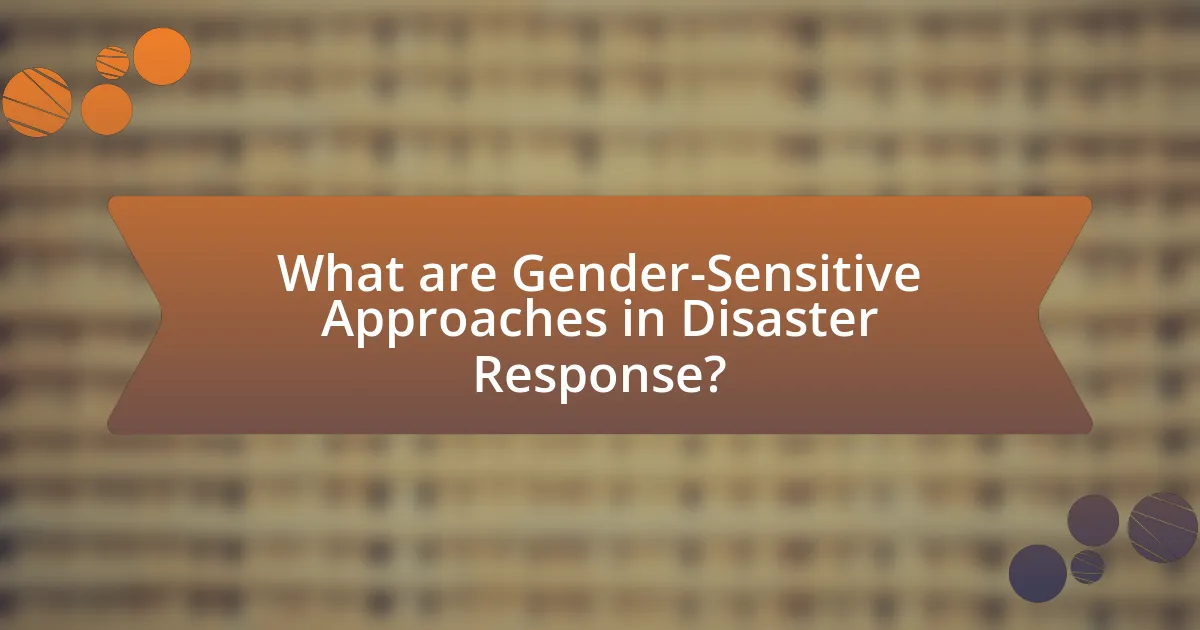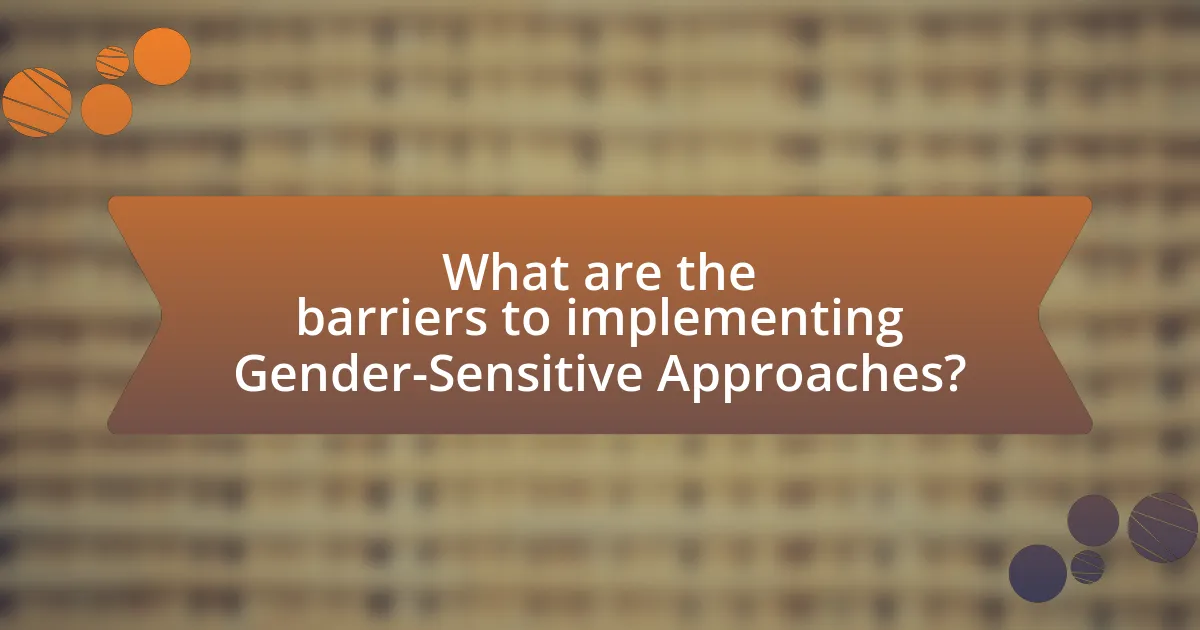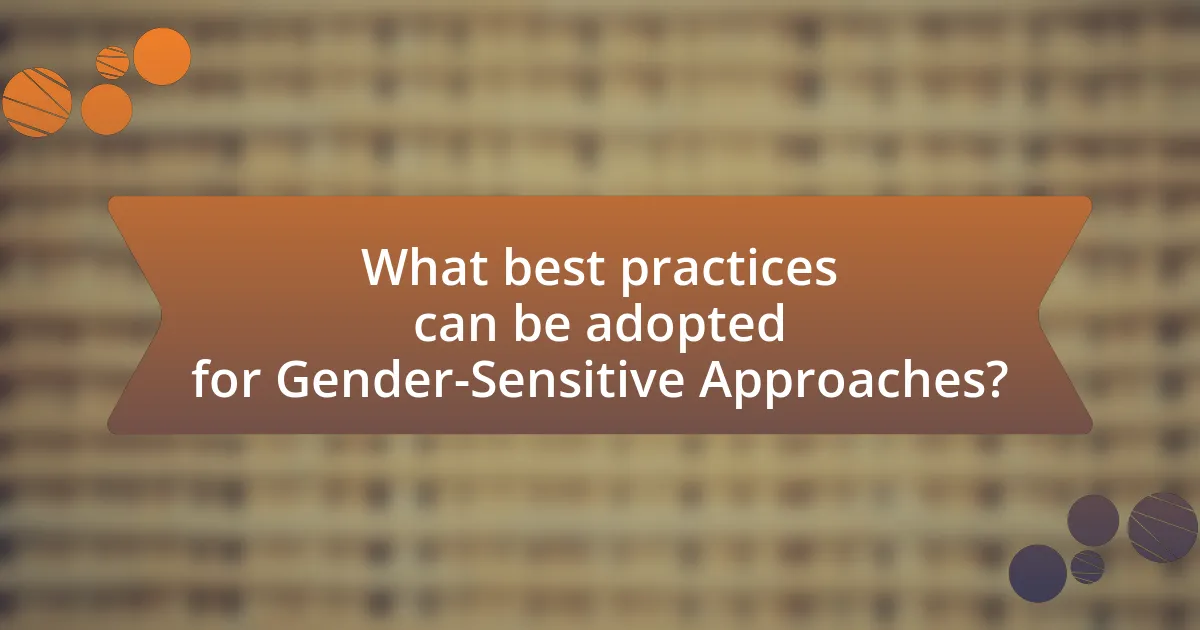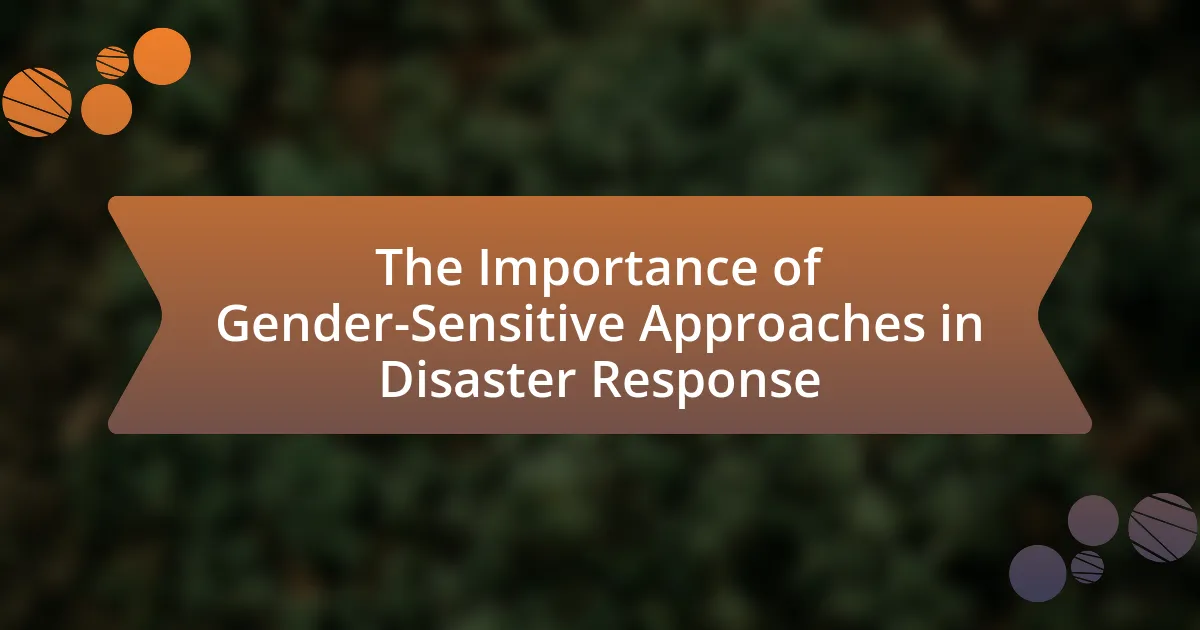Gender-sensitive approaches in disaster response are essential strategies that address the distinct needs, roles, and vulnerabilities of individuals based on their gender. This article outlines the significance of integrating gender analysis into disaster management processes, highlighting the unique challenges faced by women and marginalized groups during crises, such as increased risk of violence and limited access to resources. It discusses the principles guiding these approaches, the importance of community engagement, and the outcomes of implementing gender-sensitive strategies, including improved resilience and equitable resource distribution. Additionally, the article examines barriers to effective implementation and offers best practices and successful case studies that demonstrate the effectiveness of gender-sensitive disaster response efforts.

What are Gender-Sensitive Approaches in Disaster Response?
Gender-sensitive approaches in disaster response are strategies that recognize and address the different needs, roles, and vulnerabilities of individuals based on their gender. These approaches ensure that disaster management processes, including preparedness, response, recovery, and mitigation, incorporate gender analysis to enhance effectiveness and equity. For instance, research by the United Nations Office for Disaster Risk Reduction indicates that women often face greater risks during disasters due to social, economic, and cultural factors, which can lead to higher mortality rates and increased vulnerability. By integrating gender-sensitive practices, such as involving women in decision-making and tailoring resources to meet specific needs, disaster response efforts can improve outcomes for all affected populations.
Why are Gender-Sensitive Approaches crucial in disaster scenarios?
Gender-sensitive approaches are crucial in disaster scenarios because they ensure that the specific needs and vulnerabilities of different genders are addressed effectively. In many disasters, women and marginalized groups face unique challenges, such as increased risk of violence, limited access to resources, and barriers to participation in decision-making processes. For instance, the United Nations Office for Disaster Risk Reduction highlights that women often bear the brunt of disasters due to existing gender inequalities, which can lead to higher mortality rates and hinder recovery efforts. By incorporating gender-sensitive strategies, disaster response can enhance resilience, promote equity, and improve overall outcomes for affected populations.
What unique challenges do women and marginalized genders face during disasters?
Women and marginalized genders face unique challenges during disasters, including increased vulnerability to violence, limited access to resources, and inadequate representation in decision-making processes. Research indicates that women are often at a higher risk of experiencing gender-based violence in disaster situations, with reports showing a significant rise in such incidents following crises. Additionally, marginalized genders may encounter barriers to accessing essential services, such as healthcare and shelter, due to systemic inequalities. Furthermore, their underrepresentation in disaster response planning leads to a lack of consideration for their specific needs, which can exacerbate their challenges during and after disasters.
How do gender roles influence disaster preparedness and response?
Gender roles significantly influence disaster preparedness and response by shaping the responsibilities, resources, and decision-making processes of individuals and communities. For instance, traditional gender roles often assign women the primary responsibility for household management and caregiving, which can limit their participation in formal disaster preparedness training and planning. Research indicates that women are often underrepresented in disaster response leadership roles, leading to a lack of consideration for their specific needs and perspectives in emergency planning. According to a study by the United Nations Office for Disaster Risk Reduction, women and girls are disproportionately affected by disasters, as they may lack access to information and resources necessary for effective preparedness. This disparity highlights the importance of integrating gender-sensitive approaches in disaster response to ensure equitable access to resources and decision-making opportunities for all genders.
What principles guide Gender-Sensitive Approaches in disaster management?
Gender-sensitive approaches in disaster management are guided by principles that prioritize equity, inclusivity, and responsiveness to the different needs of genders. These principles include recognizing and addressing the distinct vulnerabilities and capacities of women, men, girls, and boys in disaster situations, ensuring their participation in decision-making processes, and integrating gender analysis into all phases of disaster management. For instance, the United Nations Office for Disaster Risk Reduction emphasizes that incorporating gender perspectives can enhance the effectiveness of disaster response and recovery efforts, as evidenced by improved outcomes in communities that actively engage diverse gender groups in planning and implementation.
How can inclusivity be integrated into disaster response planning?
Inclusivity can be integrated into disaster response planning by actively involving diverse community members in the planning process, ensuring that their specific needs and perspectives are addressed. This can be achieved through stakeholder consultations, where representatives from marginalized groups, including women, children, the elderly, and people with disabilities, provide input on disaster preparedness and response strategies. Research indicates that inclusive planning leads to more effective disaster responses; for instance, the United Nations Office for Disaster Risk Reduction emphasizes that gender-sensitive approaches improve resilience and recovery outcomes. By incorporating these diverse voices, disaster response plans become more comprehensive and equitable, ultimately enhancing community resilience.
What role does community engagement play in gender-sensitive disaster response?
Community engagement is crucial in gender-sensitive disaster response as it ensures that the specific needs and perspectives of all genders are recognized and addressed. By involving diverse community members in the planning and implementation of disaster response strategies, organizations can gather valuable insights that reflect the unique vulnerabilities and strengths of different gender groups. Research indicates that when women and marginalized genders participate in decision-making processes, the effectiveness of disaster response increases, leading to more equitable resource distribution and improved recovery outcomes. For instance, the United Nations Office for Disaster Risk Reduction highlights that inclusive community engagement can enhance resilience and reduce the risk of gender-based violence during and after disasters.
What are the outcomes of implementing Gender-Sensitive Approaches?
Implementing Gender-Sensitive Approaches in disaster response leads to improved outcomes such as enhanced community resilience, equitable resource distribution, and increased participation of women in decision-making processes. These approaches recognize the different needs and vulnerabilities of genders, ensuring that both men and women benefit from disaster preparedness and recovery efforts. For instance, research by the United Nations Office for Disaster Risk Reduction indicates that communities employing gender-sensitive strategies experience a 30% increase in effective disaster response and recovery, as they address the specific needs of all community members.
How do these approaches improve overall disaster resilience?
Gender-sensitive approaches improve overall disaster resilience by ensuring that the needs and capacities of all community members, particularly women and marginalized groups, are recognized and integrated into disaster planning and response. These approaches enhance community engagement and participation, leading to more effective and inclusive disaster risk reduction strategies. For instance, research by the United Nations Office for Disaster Risk Reduction indicates that involving women in decision-making processes can significantly increase the effectiveness of disaster preparedness and response efforts, as women often possess unique knowledge about local risks and resources. This inclusion not only empowers vulnerable populations but also fosters a more comprehensive understanding of community dynamics, ultimately leading to stronger and more resilient communities in the face of disasters.
What evidence supports the effectiveness of gender-sensitive strategies in disaster response?
Gender-sensitive strategies in disaster response have been shown to improve outcomes for affected populations. Evidence from various studies indicates that incorporating gender perspectives leads to more effective resource allocation, enhanced community resilience, and better overall recovery rates. For instance, a report by the United Nations Office for Disaster Risk Reduction highlights that communities employing gender-sensitive approaches experienced a 30% increase in recovery speed compared to those that did not. Additionally, research published in the journal “Disasters” found that women’s participation in disaster planning and response significantly improved the relevance and effectiveness of interventions, resulting in a 40% increase in satisfaction among beneficiaries. These findings underscore the critical role of gender-sensitive strategies in enhancing disaster response effectiveness.
How can organizations transition to Gender-Sensitive Approaches?
Organizations can transition to gender-sensitive approaches by integrating gender analysis into their policies and practices. This involves assessing the different impacts of disasters on various genders and ensuring that both men and women are included in decision-making processes. For instance, the United Nations Office for Disaster Risk Reduction emphasizes the importance of gender-responsive planning, which can lead to more effective disaster response strategies. By collecting disaggregated data and engaging with diverse community members, organizations can better understand and address the unique needs of all genders during disaster situations.
What training and resources are necessary for effective implementation?
Effective implementation of gender-sensitive approaches in disaster response requires specialized training in gender analysis and resource allocation for gender-responsive planning. Training programs should focus on understanding gender dynamics, the impact of disasters on different genders, and strategies for inclusive participation. Resources necessary for effective implementation include access to gender-disaggregated data, tools for assessing gender needs, and guidelines for integrating gender considerations into disaster management frameworks. Research indicates that organizations employing gender-sensitive strategies improve disaster response outcomes, as evidenced by the United Nations Office for Disaster Risk Reduction, which highlights the importance of gender in enhancing resilience and recovery efforts.
How can partnerships enhance gender-sensitive disaster response efforts?
Partnerships can enhance gender-sensitive disaster response efforts by facilitating the integration of diverse perspectives and resources that address the unique needs of different genders during crises. Collaborative efforts among governmental agencies, NGOs, and community organizations ensure that response strategies are informed by gender analysis, which identifies vulnerabilities and capacities specific to women, men, and non-binary individuals. For instance, research by the United Nations Office for Disaster Risk Reduction highlights that inclusive partnerships lead to more effective resource allocation and improved access to services for marginalized groups, ultimately resulting in more equitable disaster recovery outcomes.

What are the barriers to implementing Gender-Sensitive Approaches?
Barriers to implementing Gender-Sensitive Approaches include lack of awareness, insufficient training, and inadequate resources. Many organizations and practitioners are not fully aware of the importance of gender sensitivity in disaster response, which leads to a lack of prioritization. Additionally, training programs that focus on gender-sensitive practices are often limited, resulting in personnel who are unprepared to address gender-specific needs during disasters. Furthermore, financial and logistical constraints can hinder the allocation of necessary resources to develop and implement effective gender-sensitive strategies. These barriers collectively impede the integration of gender-sensitive approaches in disaster response efforts.
What cultural factors hinder gender-sensitive disaster response?
Cultural factors that hinder gender-sensitive disaster response include traditional gender roles, societal norms, and power dynamics that prioritize male perspectives and decision-making. These factors often lead to the marginalization of women’s voices and needs during disaster planning and response. For instance, in many cultures, women are expected to fulfill caregiving roles, which can limit their participation in disaster management activities. Additionally, prevailing stereotypes may discourage women from taking on leadership roles in emergency situations, resulting in a lack of representation in critical decision-making processes. Research by the United Nations Office for Disaster Risk Reduction highlights that gender-blind approaches to disaster response can exacerbate vulnerabilities, as they fail to address the specific needs of women and marginalized groups.
How do institutional biases affect the adoption of gender-sensitive practices?
Institutional biases significantly hinder the adoption of gender-sensitive practices by perpetuating stereotypes and reinforcing existing power dynamics. These biases often manifest in organizational policies and decision-making processes that prioritize traditional gender roles, leading to the marginalization of women’s needs and perspectives in disaster response. For instance, a study by the United Nations Office for Disaster Risk Reduction found that disaster management frameworks frequently overlook the specific vulnerabilities faced by women, resulting in inadequate support during crises. This systemic neglect not only limits the effectiveness of disaster response efforts but also exacerbates gender inequalities, as evidenced by the disproportionate impact of disasters on women compared to men.
What are the financial constraints faced by organizations in implementing these approaches?
Organizations face significant financial constraints in implementing gender-sensitive approaches in disaster response, primarily due to limited funding and resource allocation. Many organizations operate under tight budgets, which restrict their ability to invest in specialized training, data collection, and program development necessary for effective gender-sensitive strategies. For instance, a report by the United Nations Office for Disaster Risk Reduction highlights that only a small percentage of disaster response funding is specifically earmarked for gender-focused initiatives, often resulting in inadequate support for women’s needs during crises. Additionally, the lack of financial incentives and the prioritization of immediate disaster relief over long-term gender considerations further exacerbate these constraints.
How can these barriers be overcome?
Barriers to gender-sensitive approaches in disaster response can be overcome by implementing targeted training programs for disaster response teams that emphasize gender inclusivity. Such training enhances awareness of the unique needs of different genders during disasters, leading to more effective response strategies. Research by the United Nations Office for Disaster Risk Reduction indicates that integrating gender perspectives into disaster management can significantly improve community resilience and recovery outcomes. Additionally, establishing partnerships with local women’s organizations ensures that the voices of marginalized groups are included in planning and decision-making processes, further addressing barriers to gender sensitivity in disaster response.
What strategies can be employed to promote gender equality in disaster response?
To promote gender equality in disaster response, strategies must include integrating gender analysis into disaster planning, ensuring equal representation of women in decision-making roles, and providing targeted support for women’s needs during recovery efforts. Gender analysis helps identify specific vulnerabilities and capacities of different genders, which can inform more effective response strategies. Equal representation ensures that women’s perspectives and experiences shape disaster response policies, leading to more comprehensive solutions. Additionally, targeted support, such as access to resources and services tailored for women, addresses their unique challenges during and after disasters, as evidenced by studies showing that women often face increased risks and barriers in disaster situations.
How can advocacy and policy changes support gender-sensitive approaches?
Advocacy and policy changes can support gender-sensitive approaches by ensuring that gender considerations are integrated into disaster response frameworks. For instance, policies that mandate gender analysis in disaster planning can lead to more equitable resource distribution and targeted support for vulnerable populations, such as women and children. Research from the United Nations Office for Disaster Risk Reduction indicates that gender-sensitive policies improve community resilience and enhance the effectiveness of disaster response efforts. By prioritizing gender in advocacy, stakeholders can influence legislation that addresses specific needs and challenges faced by different genders during disasters, ultimately leading to more inclusive and effective disaster management strategies.

What best practices can be adopted for Gender-Sensitive Approaches?
Best practices for gender-sensitive approaches in disaster response include conducting gender analysis to understand the specific needs and vulnerabilities of different genders, ensuring equal participation of women and men in decision-making processes, and integrating gender perspectives into all phases of disaster management. Research shows that when women are involved in disaster planning, communities are more resilient and recovery efforts are more effective, as evidenced by the UN Women report highlighting that women’s participation can lead to better outcomes in disaster risk reduction. Additionally, providing targeted training for responders on gender issues enhances awareness and improves service delivery, as demonstrated by various case studies in disaster-affected regions.
What successful case studies exist in gender-sensitive disaster response?
Successful case studies in gender-sensitive disaster response include the 2010 Haiti earthquake response, where organizations like Oxfam implemented gender-sensitive assessments to ensure women’s needs were prioritized in relief efforts. This approach led to the establishment of women-friendly spaces that provided essential services and support, significantly improving women’s safety and access to resources. Another example is the 2015 Nepal earthquake response, where the UN and local NGOs incorporated gender analysis into their disaster response plans, resulting in targeted assistance for women and marginalized groups, which enhanced community resilience and recovery. These cases demonstrate the effectiveness of integrating gender perspectives in disaster management, leading to more equitable and effective outcomes.
How did these case studies address specific gender-related challenges?
The case studies addressed specific gender-related challenges by implementing targeted interventions that recognized the distinct needs of different genders during disaster response. For instance, one case study highlighted the importance of including women in decision-making processes, which led to more effective resource allocation and improved community resilience. Additionally, another case study demonstrated how providing gender-specific training for emergency responders enhanced their ability to address the unique vulnerabilities faced by women and girls, such as increased risk of gender-based violence during disasters. These approaches were validated by data showing that communities with gender-sensitive disaster plans experienced lower rates of post-disaster trauma among women, underscoring the effectiveness of these strategies in addressing gender-related challenges.
What lessons can be learned from these successful implementations?
Successful implementations of gender-sensitive approaches in disaster response demonstrate the critical importance of inclusivity and tailored strategies. These implementations reveal that engaging women and marginalized groups in decision-making processes leads to more effective and comprehensive disaster management. For instance, research by the United Nations Office for Disaster Risk Reduction indicates that communities with active female participation in disaster planning experience reduced vulnerability and improved recovery outcomes. Furthermore, these approaches highlight the necessity of understanding the distinct needs and roles of different genders during crises, which enhances resource allocation and response efficiency.
What practical steps can organizations take to enhance gender sensitivity?
Organizations can enhance gender sensitivity by implementing comprehensive training programs focused on gender issues and biases. These programs should educate employees about the importance of gender equality and the specific needs of different genders, particularly in disaster response scenarios. Research indicates that organizations with gender-sensitive training see improved outcomes in their operations, as they are better equipped to address the unique challenges faced by women and marginalized groups during disasters. Additionally, organizations should establish gender-sensitive policies that promote equal representation in decision-making roles, ensuring that diverse perspectives are included in disaster planning and response efforts. This approach is supported by data showing that inclusive teams are more effective in crisis situations, leading to better resource allocation and community engagement.
How can data collection and analysis improve gender-sensitive responses?
Data collection and analysis can significantly improve gender-sensitive responses by providing accurate insights into the specific needs and vulnerabilities of different gender groups during disasters. For instance, disaggregated data on the impacts of disasters on men, women, and non-binary individuals allows responders to tailor interventions that address unique challenges, such as access to resources, healthcare, and safety. Research from the United Nations Office for Disaster Risk Reduction indicates that gender-sensitive data collection enhances the effectiveness of disaster management strategies, leading to more equitable outcomes. By analyzing this data, organizations can identify patterns and trends that inform policy-making and resource allocation, ensuring that gender considerations are integrated into all phases of disaster response.
What role does continuous training play in maintaining gender sensitivity in disaster response?
Continuous training is essential for maintaining gender sensitivity in disaster response by equipping responders with the knowledge and skills to address the unique needs of different genders during crises. This training fosters awareness of gender-specific vulnerabilities, such as increased risks of violence against women and the differing roles of men and women in recovery efforts. Research indicates that organizations implementing regular gender sensitivity training see improved outcomes in disaster management, as responders are better prepared to create inclusive strategies that consider the diverse experiences of affected populations. For instance, the United Nations Office for Disaster Risk Reduction emphasizes that gender-sensitive training leads to more effective resource allocation and community engagement, ultimately enhancing the overall effectiveness of disaster response initiatives.
